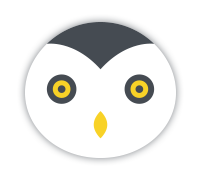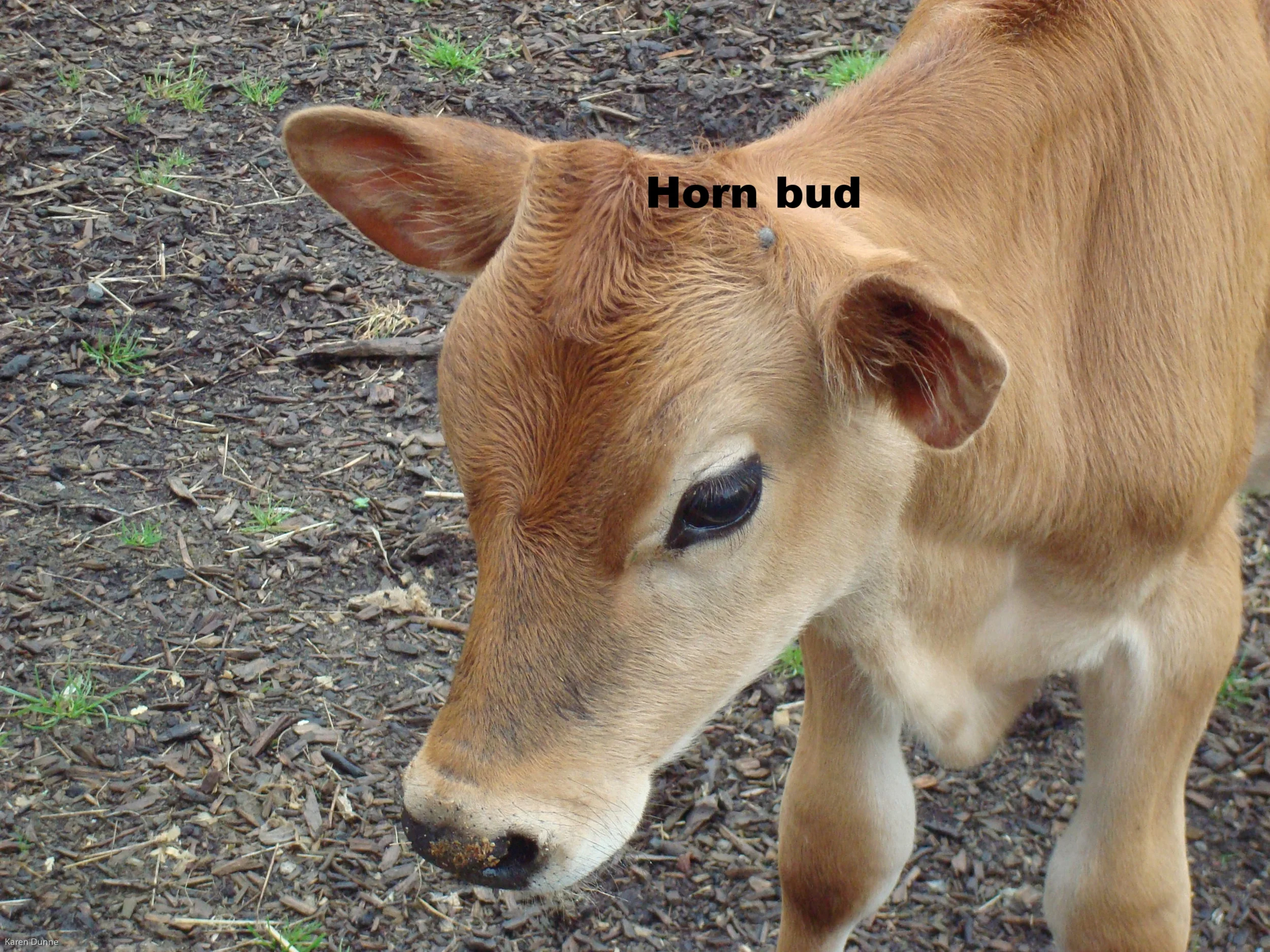overview
Cornuectomy refers to the removal of horns. Ruminants can be horned or polled (genetically lacking horns). The presence of horns varies with the species, breed, sex and age. If the animal bears horns they will grow continuously throughout its life (figure 1). Horns are potentially dangerous weapons, both to people and other animals. There is also a risk of them getting caught in gates, bars, trees etc. and trapping, injuring or even killing the animal. Horned animals are more prone to injuries during transport and at self-feeding gates. For all these reasons many domestic ruminants, especially cattle, are dehorned. Irish welfare legislation forbids the sale of horned cattle at livestock marts.
Once the decision has been made to dehorn an animal the procedure should be carried out as early in life as possible. This facilitates the removal of the immature horn buds with much less pain, bleeding and risk of complications (fly strike, sinusitis, brain abscessation) than the dehorning of adult animals.
Figure 1. This Blackface Mountain ram has impressive horns
Disbudding versus dehorning, what's the difference?
Figure 2. Horn bud on a one month old Jersey calf
Horns are not present at birth. Instead the animal has horns buds or buttons on the top of the head, between the ears, at the site where the horns will develop. They are easily palpated as hard lumps under the skin and are usually covered with an irregular tuft of hair. Removal of the horn buds is therefore referred to as disbudding. This is preferable as the buds are not yet attached to the skull and so the frontal sinus is not exposed when the buds are removed.
Dehorning refers to the removal of the horns after they have formed. They are now attached to the skull and so must be cut or sawn off.
methods of disbudding
- Chemical cautery
- Heat cautery
- Surgical removal
Chemical cautery has several drawbacks: it risks damaging the calf's skin and eyes and is irritant to other animals and people if it comes in contact with them. Ideally cattle should be kept out of the rain for several days afterwards (not easy in Ireland!) and stumps or remnants of horn often grow from the site. It also seems to result in more discomfort for the animal than other methods. It's therefore not a recommended means of disbudding.
Surgical removal is indicated in adult cattle. It requires sedation plus local analgesia before the horns are sawn or cut off. It is extremely hard work, results in unnecessary stress for both the cattle and the people involved and carries a higher complication rate. Both Veterinary Ireland and Teagasc recommend that all cattle be disbudded as calves to avoid the need for this procedure later in life.
Heat cautery is therefore the preferred method of disbudding cattle early in life and is discussed below.
Disbudding via heat cautery
A dehorning iron with an open circular tip is used to both cauterise the blood vessels to prevent healing and remove the horn bud. The irons may be heated via electricity or a butane gas cylinder. The gas-fueled irons are portable and hotter and are therefore preferred. It is a legal requirement in Ireland for local anaesthesia to be used if calves are over two weeks old when being disbudded but it's recommended that a cornual nerve block be used in all cases to avoid causing the animal any pain during the procedure. Long acting pain relief (typically a non-steroidal anti-inflammatory prescribed by the farmer's vet for this purpose) should also be administered to the calf at the time to reduce discomfort once the anaesthetic wears off. Antibiotics are not necessary.
Equipment:
Figure 3. Portable calf crate with head restraint
- Calf crate with head restraint (figure 3)
- Curved scissors with blunt tips
- Handwashing facilities (clean water, soap, clean/disposable towel)
- Disposable gloves
- 4-6ml of local anaesthetic solution (Adrenacaine) per calf
- Sterile 1" 20 gauge needles
- Sterile 10ml syringes
- Dehorning iron
- Spare butane gas cartridge
- Gauze swabs soaked in 70% isopropyl alcohol
- Analgesic solution for injection
- Antiseptic aerosol spray e.g. Aluspray
- Sharps container
- Clinical waste bin
- Refuse bin
- Veterinary prescriptions for the medications
Method
Wipe the seal on the bottle of local anaesthetic with a swap and aseptically draw up 6ml of local anaesthetic in a 10ml syringe.
Place the calf in the crate. Wash and dry your hands and put on disposable gloves. Inject 3ml of local anaesthetic over the cornual nerve on each side of the head. Do this by running your finger along the head from the lateral canthus of the eye to the horn bud. About 3cm from the eye along this line you will feel a bony ridge. Soak the hair coat under this ridge with a swab - be extremely careful not to let the alcohol contact the calf's eyes as it can damage the cornea. Insert the needle through the skin under this ridge, draw back to check you're not in a blood vessel and then deposit the anaesthetic at this site (see video 1).
Wait for at least five minutes to allow the anaesthetic time to work. You can tell it has taken effect when the calf's eyelashes start to droop towards the ground. If this hasn't occurred after ten minutes, repeat the anaesthetic injection. Meanwhile, clip away the hair over the horn buds with the scissors and heat the disbudding iron until it is cherry red in colour. Once everything is ready secure the calf's head in the crate (being careful not to obstruct the airway).
To remove the horn place the iron over the bud and apply light pressure in a circular rocking motion to scoop out the bud. The calf may move slightly so be careful not to burn either it or yourself with the iron. However the calf should not vocalise or struggle: if it does your block may not have been fully effective.
Spray on the antiseptic and administer the pain relief: most NSAIDs in calves are given subcutaneously so swab a site over the ribs behind the elbow and administer the injection there before releasing the calf. The veterinary practitioner will need to prescribe the local anaesthetic and analgesics so ensure the farmer receives their copy of the prescriptions to complete their Animal Remedies Record.
Use a new needle and syringe for every injection and dispose of all waste once the task is complete.
The video below demonstrates the procedure and is from Tommy Heffernan, MVB. See his website and YouTube channel for more useful resources, or follow him on Twitter @tommythevet
Sheep are not routinely dehorned but some clients may request the dehorning of kid goats. This is carried out via heat cautery in a manner similar to calves. This procedure should be performed by a veterinary practitioner (unless the client is very experienced), as due to the more central location of the horn buds in goats there is a risk of thermal damage to the skull and brain if the iron is applied for too long.
further reading
Holtgrew-Bohling, K. (2016). Dehorning. In Large Animal Clinical Procedures for Veterinary Technicians. 3rd ed. St Louis: Mosby Elsevier, pp.548-549.
Holtgrew-Bohling, K. (2016). Cornuectomy. In Large Animal Clinical Procedures for Veterinary Technicians. 3rd ed. St Louis: Mosby Elsevier, pp.470-472.



